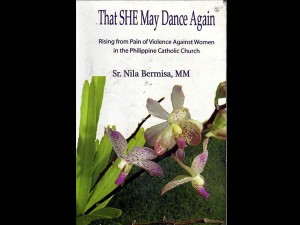
The journey began in December 2000, when the Women and Gender Commission (WGC) of the Association of Major Religious Superiors of the Philippines (AMRSP) wrote the Catholic Bishops’ Conference of the Philippines (CBCP) in anticipation of the Bishops’ meeting the following year. The AMRSP was looking into the possibility of the bishops issuing a pastoral letter on the situation of women in the country.
“The ‘Letter of Concern’ presented our collective experience and observation on the situation of women,” recalls Sr. Nila Bermisa, MM, coordinator of the WGC, in her book That She May Dance Again. “It discussed various instances of violence perpetrated against women, including sexual abuses by the clergy.”
The CBCP Episcopal Commission on Mutual Relations between the Clergy and Religious (ECMR) set a meeting to look deeper into the matter. It was Sr. Nila who met with the bishops in her capacity as member of both the WGC, where she represented her congregation, and the AMRSP, where she sat on the Executive Board from 2002 to 2005.
At the meeting, Sr. Nila was stunned by the CBCP’s reaction to the “Letter of Concern,” particularly the inclusion of “sexual abuses by priests.” “They claimed that feminists among the women who were trained in the United States had influenced the efforts to expose such a sensitive issue.”
As she drove away from the CBCP Compound, Sr. Nila asked herself: “Are these men blind or deaf to what is happening around them?”
Asked to substantiate its claims of sexual abuses, the WGC formed a research committee composed of Sr. Nila and two researchers, Volet and Juanita. Sr. Nila was then Dean of the Institute of Formation and Religious Studies (IFRS), where she had taken her Master’s degree.
In November 2001, the team began interviewing survivors of sexual abuse in 19 archdioceses, dioceses and prelatures. From December 2001 to May 2002, the team was able to document 30 cases, half of which were classified as cases of sexual abuse. More than one-third or 36.7 percent of the cases could be considered rape under civil law, while 13.3 percent would qualify as ephebophilia (sexual attraction for adolescents). Twenty-two of the 30 cases involved women survivors.
The research committee also documented 11 phone calls and text messages from as far as the United States, reporting cases of sexual harassment, fondling, hugging and kissing during a retreat, an ongoing relationship, an affair that resulted in the birth of a son, and a homosexual relationship. Cases of alleged sexual abuse by the clergy were discussed at gatherings at the request of church workers, women religious and other groups.
After six months, the researchers gave a partial report at a meeting with members of the ECMR. Parts of the report came out in a national newspaper, while information on abuses and misconduct by the clergy also began circulating, released by other women’s groups.
“The publicity,” recalls Sr. Nila, “created confusion among people… Although the bishops could no longer ignore the reports, they [said] that this was not representative of the clergy in general.”
In the meantime, the WGC Research Committee began receiving requests for help from men and women who had experienced sexual abuse and those who wanted to break free of their relationships with members of the clergy. In response, the Committee started its “Pastoral Ministry toward Healing of Sexually Abused Women,” while convents began accommodating women victims who needed a place to stay.
“One congregation of women religious allowed us to use an old residence to house Talitha Cum,” says Sr. Nila. The center was named after the command of Jesus to the dead daughter of a high Jewish official: “Little girl, arise.”
“It provided a safe house and a supportive environment while the women survivors rested and regrouped for their next step to seek justice and pursue charges against their perpetrators. Referrals for counseling, therapy, legal, medical and professional help, as well as assistance in looking for a job or source of livelihood, were also made available,” writes Sr. Nila. “Our goal was to get [the women to become] independent and regain self-confidence while realizing that the work of self-empowerment and healing was a long process.”
Sr. Nila was involved in the research and operation of Talitha Cum until she left in 2005 to be the Congregational Vocation Director of the Maryknoll Sisters based in New York. She later used her experiences at Talitha Cum to write her dissertation “Women Rising from the Pain of Sexual Violence in the Catholic Church in the Philippines: A Journey towards Freedom and Wholeness,” to complete her doctorate at the San Francisco Theological Seminary.
That academic document was later published into a book that was launched in March this year to coincide with the celebration of Women’s Month. The book, the Maryknoll sister explains, features documented cases responded to by Talitha Cum from 2001to 2004. “Only two cases are discussed in detail [those of Mari, a parish worker, and Ana, a nun who eventually left the convent]. The rest of the study discusses the collective experiences of women victims and survivors of sexual violence perpetuated by clergy and religious brothers in the (Roman Catholic) Church in the Philippines.”
Sr. Nila sought assistance from Febe Aguirre of the Guidance and Counseling Department of the University of the Philippines to help the women survivors overcome their feelings of anger, guilt, shame, fear, distress, self-blame, feeling of worthlessness, confusion and powerlessness “by slowly fostering in themselves positive self-image and acceptance.”
Says Aguirre: “In the process of talking about her experience, a woman survivor tries to make sense of her life, her being, her experience and her reality.”
Sr. Nila particularly notes the resilience of the survivors, and their instinct to survive way beyond what could be considered reasonable. Such resilience and faith, she hopes, will prevail and lead the women to laugh and dance again.
But she also urges the Church to facilitate the realization of the new land as foretold by the prophet Isaiah. In this new environment, she envisions that each woman is recognized as a full human being with dignity and integrity, where their voices are heard, their cries against injustice listened to, and their demands for transformation heeded. Women’s Feature Service











































